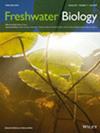给我庇护:避难所的可用性与同密度和捕食者的化学线索相互作用,影响蝌蚪和变形
IF 2.7
2区 生物学
Q2 ECOLOGY
引用次数: 0
摘要
如果捕食者的存在引发了防御特征的表达,从而消耗了资源,损害了其他重要功能,那么捕食者可能会对猎物造成非消耗性的影响。尽管如此,如果外来因素,无论是生物的还是非生物的,提供了抗捕食者的保护,这些影响可能会更温和。我通过饲养伊比利亚绿蛙(Pelophylax perezi López-Seoane 1885)蝌蚪来验证这一假设,这些蝌蚪要么单独饲养,要么成群饲养,要么暴露在捕食者的化学信号中,要么没有避难所。我还研究了这些处理对最终变质的潜在延续效应。暴露于捕食者化学线索的单独饲养的幼虫生长和游动得更快,但群体饲养的幼虫不遵循这些趋势。相反,它们长出不那么深的尾巴是对捕食者的化学信号的反应,这与大多数无尾目动物的一般趋势相反。无论密度如何,避难所的存在都会导致尾巴变短,当与捕食者的化学信号结合时,速度会变慢。在捕食压力下,单养个体的发育速度更快,蜕变时间也更短。尽管如此,变形并不像幼虫那样遵循相同的模式,在群体饲养的个体中,当暴露于捕食者的化学线索时,没有避难所,身体大小和运动是最差的。因此,暴露于捕食者线索的单独饲养的幼虫似乎比群体饲养的幼虫更倾向于躲避捕食者。避难所减少了在移动上的投资。然而,在变形中发现的模式表明,压力是由同种生物的竞争、捕食风险和变形后避难所的缺失共同造成的。这些结果有助于理清捕食压力(作为压力源)、避难(作为压力的平衡物)和同种生物(作为竞争来源和在不同生命阶段缓解压力)之间的复杂联系。本文章由计算机程序翻译,如有差异,请以英文原文为准。
Gimme Shelter: Refuge Availability Interacts With Conspecific Density and Predator Chemical Cues to Affect Tadpoles and Metamorphs
- Predators may inflict non-consumptive effects on their prey if their presence triggers the expression of defensive traits which consume resources to the detriment of other vital functions. Nonetheless, these effects can be milder if extrinsic factors, either biotic or abiotic, provide antipredator protection.
- I tested this hypothesis by rearing Iberian green frog (Pelophylax perezi López-Seoane 1885) tadpoles either singly or in groups, exposed or not to predator chemical cues, with or without a refuge. I also studied potential carryover effects of such treatments on the resulting metamorphs.
- Singly-reared larvae exposed to predator chemical cues grew and swam faster, but group-reared larvae did not follow these trends. Instead, they grew less deep tails as a response to predator chemical cues, which is against the general tendency of most anurans. Irrespective of density, the presence of a refuge induced shorter tails, and when combined with predator chemical cues, slower speed. Development was also faster, and time to metamorphosis shorter in singly-reared individuals under predation pressure. Nonetheless, metamorphs did not follow the same patterns as larvae, and body size and locomotion were at their worst in group-reared individuals which had no refuge while being exposed to predator chemical cues.
- Therefore, singly-reared larvae exposed to predator cues seemingly invest more in predator avoidance than those reared in a group. Refuges relieve the investment in locomotion. The patterns found in metamorphs, however, suggest the stress resulting from the combination of competition by conspecifics, predation risk and the absence of a refuge echoes after metamorphosis.
- These results help disentangle the intricate connections between predation pressure as a stressor, refuge as a counter-weight to it and the presence of conspecifics as a source of competition and a relief from pressure at different life stages.
求助全文
通过发布文献求助,成功后即可免费获取论文全文。
去求助
来源期刊

Freshwater Biology
生物-海洋与淡水生物学
CiteScore
5.90
自引率
3.70%
发文量
162
审稿时长
2 months
期刊介绍:
Freshwater Biology publishes papers on all aspects of the ecology of inland waters, including rivers and lakes, ground waters, flood plains and other freshwater wetlands. We include studies of micro-organisms, algae, macrophytes, invertebrates, fish and other vertebrates, as well as those concerning whole systems and related physical and chemical aspects of the environment, provided that they have clear biological relevance.
Studies may focus at any level in the ecological hierarchy from physiological ecology and animal behaviour, through population dynamics and evolutionary genetics, to community interactions, biogeography and ecosystem functioning. They may also be at any scale: from microhabitat to landscape, and continental to global. Preference is given to research, whether meta-analytical, experimental, theoretical or descriptive, highlighting causal (ecological) mechanisms from which clearly stated hypotheses are derived. Manuscripts with an experimental or conceptual flavour are particularly welcome, as are those or which integrate laboratory and field work, and studies from less well researched areas of the world. Priority is given to submissions that are likely to interest a wide range of readers.
We encourage submission of papers well grounded in ecological theory that deal with issues related to the conservation and management of inland waters. Papers interpreting fundamental research in a way that makes clear its applied, strategic or socio-economic relevance are also welcome.
Review articles (FRESHWATER BIOLOGY REVIEWS) and discussion papers (OPINION) are also invited: these enable authors to publish high-quality material outside the constraints of standard research papers.
 求助内容:
求助内容: 应助结果提醒方式:
应助结果提醒方式:


